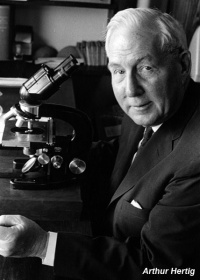Paper - the primary human oocyte - some observations on the fine structure of Balbiani's vitelline body and the origin of the annulate lamellae: Difference between revisions
(Created page with "{{Header}} {{Ref-Hertig1968a}} {| class="wikitable mw-collapsible mw-collapsed" ! Online Editor |- |50px|left This historic 1968 paper describes e...") |
mNo edit summary |
||
| Line 19: | Line 19: | ||
{{Historic Disclaimer}} | {{Historic Disclaimer}} | ||
=The primary human oocyte - Some observations on the fine structure of Balbiani's vitelline body and the origin of the annulate lamellae= | =The primary human oocyte - Some observations on the fine structure of Balbiani's vitelline body and the origin of the annulate lamellae= | ||
[[File:Arthur Hertig.jpg|thumb|200px|alt=Arthur T Hertig|link=Embryology History - Arthur Hertig|Arthur Tremain Hertig (1904-1990)]] | |||
Revision as of 17:48, 19 April 2018
| Embryology - 24 Apr 2024 |
|---|
| Google Translate - select your language from the list shown below (this will open a new external page) |
|
العربية | català | 中文 | 中國傳統的 | français | Deutsche | עִברִית | हिंदी | bahasa Indonesia | italiano | 日本語 | 한국어 | မြန်မာ | Pilipino | Polskie | português | ਪੰਜਾਬੀ ਦੇ | Română | русский | Español | Swahili | Svensk | ไทย | Türkçe | اردو | ייִדיש | Tiếng Việt These external translations are automated and may not be accurate. (More? About Translations) |
Hertig AT. The primary human oocyte: some observations on the fine structure of Balbiani's vitelline body and the origin of the annulate lamellae. (1968) Amer. J Anat. 122: 107-37. PMID 5654499
| Online Editor |
|---|
| This historic 1968 paper describes early human oocyte structure. Draft only.
Hertig AT. and Rock J. Two human ova of the pre-villous stage, having a developmental age of about seven and nine days respectively. (1945) Contrib. Embryol., Carnegie Inst. Wash. Publ. 557, 31: 65-84. Hertig AT. and Rock J. On a normal human ovum not over 7.5 days of age. (1945) Anat. Rec. 91: 281. Hertig AT. and Rock J. On a normal ovum of approximately 9 to 10 days of age. (1945) Anat. Rec. 91: 281.
|
| Historic Disclaimer - information about historic embryology pages |
|---|
| Pages where the terms "Historic" (textbooks, papers, people, recommendations) appear on this site, and sections within pages where this disclaimer appears, indicate that the content and scientific understanding are specific to the time of publication. This means that while some scientific descriptions are still accurate, the terminology and interpretation of the developmental mechanisms reflect the understanding at the time of original publication and those of the preceding periods, these terms, interpretations and recommendations may not reflect our current scientific understanding. (More? Embryology History | Historic Embryology Papers) |

